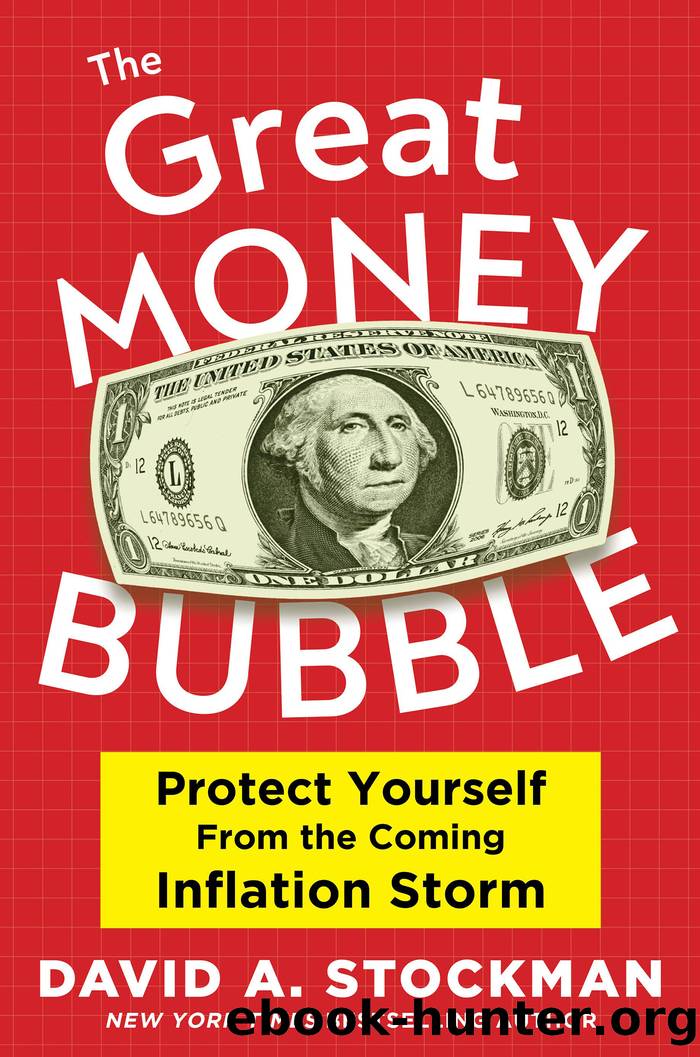The Great Money Bubble by David Stockman

Author:David Stockman [Stockman, David A.]
Language: eng
Format: epub
Tags: BUS016000 BUSINESS & ECONOMICS / Consumer Behavior, BUS019000 BUSINESS & ECONOMICS / Decision-Making & Problem Solving, BUS022000 BUSINESS & ECONOMICS / Economic Conditions, BUS023000 BUSINESS & ECONOMICS / Economic History, BUS029000 BUSINESS & ECONOMICS / Free Enterprise & Capitalism, BUS031000 BUSINESS & ECONOMICS / Inflation
Publisher: Humanix Books
Amazon: Overvalued by Any Measure
At the end of the day, valuations do matter, and thatâs why the valuation of the very highest-flyer of the present bubble cycle, Amazon, is so hideously excessive. Indeed, as I explain further later, we seriously doubt that it will ever post earnings remotely consistent with its current $1.7 trillion market cap. Thatâs because its gigantic e-commerce business is not a profit maker, and the overwhelming share of Amazonâs modest earnings of $29 billion on $443 billion in sales is due to its Amazon Web Services (AWS) cloud business, a classic case of a one-time shift of technology that will soon reach its GDP-anchored limits.
Itâs worth remembering that when stocks appear to grow to the sky, skydiving is next on the agenda. For instance, during the years from 1998 to 2000, the Nasdaq-100 appeared to attain liftoff from a tenuous mooring to the net income of its constituent companies, rising by 300 percent to a peak of 4,700 in less than 24 months.
Then came the March 27, 2000 blow-off top. Twenty trading days later, the index was down by a gut-wrenching 30 percent, only to stutter long enough at 3,000 for buy-the-dippers to come in for one last killing, a slaughter that proved to be their own. By October 2002, the index had lost 83 percent of its peak value. At 800, it posted lower than way back in December 1996, when Greenspan first warned about irrational exuberance and no one paid attention, including the âmaestroâ himself.
That was a warm-up. Consider the same chart today, which is destined to become the Nasdaq-100 blow-off top of the near future. This time it took a tad longer to reach low-earth orbit at 16,000, but the index did touch 7,000 as recently as March 23, 2020, when the U.S. economy hit the skids under the lockdown shock, leading the Fed to run the printing presses round-the-clock.
Download
This site does not store any files on its server. We only index and link to content provided by other sites. Please contact the content providers to delete copyright contents if any and email us, we'll remove relevant links or contents immediately.
International Integration of the Brazilian Economy by Elias C. Grivoyannis(92164)
The Radium Girls by Kate Moore(11935)
Turbulence by E. J. Noyes(7943)
Nudge - Improving Decisions about Health, Wealth, and Happiness by Thaler Sunstein(7622)
The Black Swan by Nassim Nicholas Taleb(7016)
Rich Dad Poor Dad by Robert T. Kiyosaki(6414)
Pioneering Portfolio Management by David F. Swensen(6231)
Man-made Catastrophes and Risk Information Concealment by Dmitry Chernov & Didier Sornette(5926)
Zero to One by Peter Thiel(5693)
Secrecy World by Jake Bernstein(4653)
Millionaire: The Philanderer, Gambler, and Duelist Who Invented Modern Finance by Janet Gleeson(4386)
The Age of Surveillance Capitalism by Shoshana Zuboff(4216)
Skin in the Game by Nassim Nicholas Taleb(4165)
Bullshit Jobs by David Graeber(4101)
The Money Culture by Michael Lewis(4083)
Skin in the Game: Hidden Asymmetries in Daily Life by Nassim Nicholas Taleb(3935)
The Dhandho Investor by Mohnish Pabrai(3706)
The Wisdom of Finance by Mihir Desai(3659)
Blockchain Basics by Daniel Drescher(3511)
